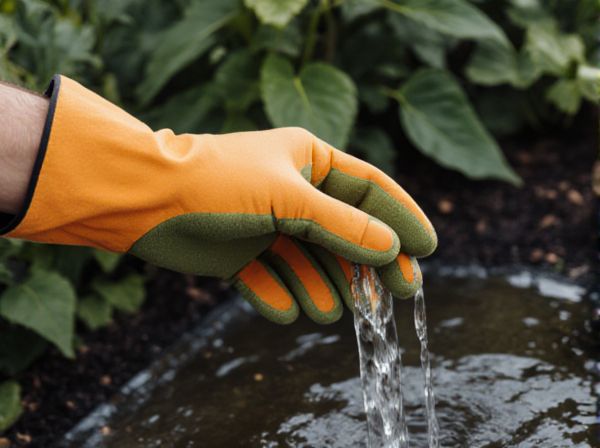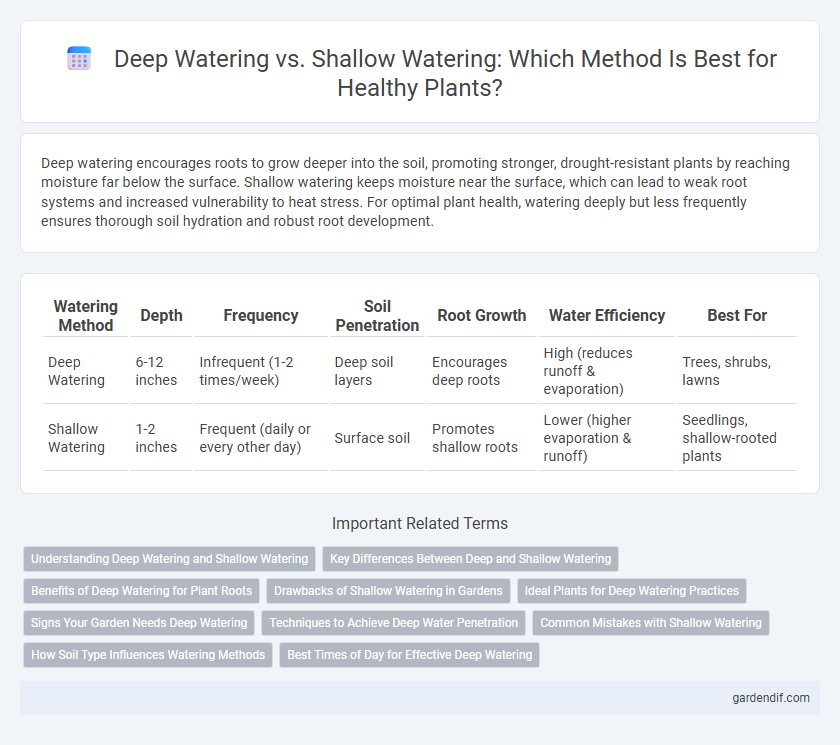
Deep watering vs Shallow watering Illustration
Deep watering encourages roots to grow deeper into the soil, promoting stronger, drought-resistant plants by reaching moisture far below the surface. Shallow watering keeps moisture near the surface, which can lead to weak root systems and increased vulnerability to heat stress. For optimal plant health, watering deeply but less frequently ensures thorough soil hydration and robust root development.
Table of Comparison
| Watering Method | Depth | Frequency | Soil Penetration | Root Growth | Water Efficiency | Best For |
|---|---|---|---|---|---|---|
| Deep Watering | 6-12 inches | Infrequent (1-2 times/week) | Deep soil layers | Encourages deep roots | High (reduces runoff & evaporation) | Trees, shrubs, lawns |
| Shallow Watering | 1-2 inches | Frequent (daily or every other day) | Surface soil | Promotes shallow roots | Lower (higher evaporation & runoff) | Seedlings, shallow-rooted plants |
Understanding Deep Watering and Shallow Watering
Deep watering promotes root growth by delivering moisture several inches below the soil surface, encouraging plants to develop strong, drought-resistant roots. Shallow watering moistens only the top layer of soil, leading to weak root systems that are more susceptible to drying out and environmental stress. Proper irrigation practices balance deep watering to sustain plant health while avoiding excess shallow watering that can cause surface evaporation and nutrient loss.
Key Differences Between Deep and Shallow Watering
Deep watering penetrates soil to a depth of 6 to 12 inches, promoting strong root growth and drought resistance, while shallow watering only moistens the surface 1 to 3 inches, encouraging weak roots and frequent watering. Deep watering reduces water runoff and evaporation, increasing water use efficiency, whereas shallow watering leads to higher water loss and less effective irrigation. Understanding these key differences helps optimize plant health and conserve water resources in gardening and agriculture.
Benefits of Deep Watering for Plant Roots
Deep watering promotes extensive root growth by encouraging roots to grow deeper into the soil, which enhances plant stability and access to nutrients and moisture. Deeper root systems improve drought resistance, reducing the frequency of watering needed and increasing overall plant health. This method also minimizes surface evaporation and runoff, ensuring efficient water usage and sustained soil hydration.
Drawbacks of Shallow Watering in Gardens
Shallow watering in gardens leads to weak root systems as moisture only penetrates the top few inches of soil, causing plants to become drought-stressed quickly. This method encourages roots to stay near the surface, making them vulnerable to temperature fluctuations and drought conditions. Frequent shallow watering also increases the risk of fungal diseases and promotes weed growth, reducing overall garden health and productivity.
Ideal Plants for Deep Watering Practices
Deep watering is ideal for deep-rooted plants such as trees, shrubs, and established perennials, as it promotes extensive root growth and improves drought resistance. These plants benefit from infrequent, thorough watering that penetrates 12 inches or more into the soil, encouraging roots to grow downward for better nutrient absorption. In contrast, shallow watering suits shallow-rooted plants like annuals and seedlings, which require more frequent moisture at the soil surface.
Signs Your Garden Needs Deep Watering
Wilting leaves and dry, compacted soil are clear signs your garden requires deep watering to encourage roots to grow downwards. Shallow watering leads to surface-root growth, which makes plants more vulnerable to drought and heat stress. Observing these indicators ensures your garden receives sufficient moisture for healthy, resilient growth.
Techniques to Achieve Deep Water Penetration
Deep watering techniques involve applying water slowly and evenly to ensure moisture reaches the root zone, typically 12 to 18 inches deep, promoting stronger root development and drought resistance. Using drip irrigation systems or soaker hoses allows precise control and reduces surface runoff, while scheduling watering early in the morning minimizes evaporation loss. Testing soil moisture regularly with a probe helps adjust watering duration to maintain optimal deep soil hydration without overwatering.
Common Mistakes with Shallow Watering
Shallow watering often leads to weak root systems because it encourages roots to grow near the soil surface, making plants more vulnerable to drought and heat stress. Common mistakes include watering too frequently but with insufficient depth, resulting in nutrient deficiencies and increased weed growth. Proper deep watering promotes healthier, drought-resistant plants by encouraging roots to grow deeper into the soil where moisture is more stable.
How Soil Type Influences Watering Methods
Soil type plays a crucial role in determining the effectiveness of deep watering versus shallow watering techniques. Sandy soils, with their large particles and high permeability, require frequent shallow watering to maintain moisture near the surface, while clay soils, known for retaining water longer, benefit from deep watering that promotes root growth and prevents surface evaporation. Loam soils strike a balance, allowing flexibility in watering methods, but deep watering generally supports healthier root systems by encouraging roots to penetrate deeper into the soil profile.
Best Times of Day for Effective Deep Watering
Deep watering is most effective during early morning hours when evaporation rates are low, allowing water to penetrate deeply into the soil and reach plant roots. Evening watering can also be beneficial, but it may increase the risk of fungal diseases due to prolonged moisture on foliage. Avoid midday watering to reduce water loss from evaporation and to ensure maximum soil moisture retention for healthy plant growth.
Deep watering vs Shallow watering Infographic

 gardendif.com
gardendif.com